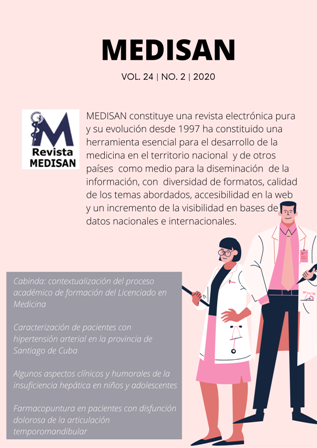Characterization of bacterial agents isolated in diseases outbreaks transmitted by foods
Keywords:
diseases transmitted by foods, epidemiological markers, bacterial agents, stool culture, culture means.Abstract
Introduction: Diseases transmitted by foods are produced due to ingestion of a food, including water that can be contaminated by diverse agents.
Objective: To characterize the bacterial agents isolated in diseases outbreaks transmitted by foods.
Methods: An observational, descriptive and cross-sectional study of 100.0 % of the diseases outbreaks transmitted by foods in Santiago de Cuba, from January, 2018 to December, 2019 was carried out, for which samples of foods and stools were selected. The characterization of the isolated bacterias was based on the results of growth and other biochemical-metabolic tests. Results of the isolation and confirmation of agents identified in each one of the outbreaks from the samples mentioned above were used. Among the analyzed variables we can mention: number of outbreaks, samples of foods, samples of stools and results of biochemical and metabolic tests.
Results: An isolation of bacterial agents was obtained in 100.0 % of foods samples. There was a higher frequency of Gram negative bacterias (82.0 %) and the lower corresponded to Gram positive microorganisms (18.0 %). Salmonella D was the most frequent microorganism.
Conclusions: This result represents an instrument for the etiological diagnosis of diseases outbreaks transmitted by foods in Santiago de Cuba.Downloads
References
2. Cortés Sánchez A. Bacilluscereus: Alimentos, salud y biotecnología. AP. 2017. [citado 28/08/2019]; 10 (10). Disponible en: http://www.revista-agroproductividad.org/index.php/agroproductividad/article/view/98
3. Torres Ramírez RM. Conocimientos, actitudes y prácticas en higiene y manipulación de alimentos de los trabajadores en los restaurantes de Miraflores y Lurigancho - Chosica, 2017. [Tesis]. Lima: Universidad Peruana Unión. Facultad Ciencias de la Salud; 2017 [citado 28/08/2019]. Disponible en: https://repositorio.upeu.edu.pe/bitstream/handle/UPEU/910/Madelen_Tesis_Bachiller_2017.pdf?sequence=4&isAllowed=y
4. Alarcón Lavín MP, Oyarzo C, Escudero C, Cerda Leal F, Valenzuela FJ. Portación de Staphylococcus aureus enterotoxigénico tipo A, en frotis nasofaríngeos en manipuladores de alimentos. Rev. Méd. Chile. 2017 [citado 28/08/2019]; 145(12): 1559-64. Disponible en: https://scielo.conicyt.cl/scielo.php?script=sci_arttext&pid=S0034-98872017001201559&lng=es. http://dx.doi.org/10.4067/s0034-98872017001201559
5. Palomino Camargo C, González Muñoz Y, Pérez Sira E, Aguilar VH. Metodología Delphi en la gestión de la inocuidad alimentaria y prevención de enfermedades transmitidas por alimentos. Rev Peru Med Exp Salud Pública. 2018 [citado 28/08/2019];35(3): 483-90. Disponible en: https://www.scielosp.org/article/rpmesp/2018.v35n3/483-490/
6. Cardona Durruthy J, Legró Pérez MC, Bertrán Suárez Y, Rodríguez Hinojosa M, Estévez Reyes I. Problemas medioambientales y transmisión de enfermedades por alimentos. Rev. inf. cient. 2018 [citado 01/11/2019]; 97(2): 387-97. Disponible en: http://scielo.sld.cu/scielo.php?script=sci_arttext&pid=S1028-99332018000200387&lng=es
7. Sánchez Suárez- Otero M. Seguridad alimentaria: desarrollo de microorganismos en ovoproductos. [Tesis]. España: Universidad de Oviedo; 2017 [citado 01/11/2019]. Disponible en:http://hdl.handle.net/10651/43789
8. Pupo Rodríguez G, Bello Fernández ZL, Pavón Ramírez MA, Pacheco Pérez Y, Lluch Silva IT. Brotes de intoxicación alimentaria ocurridos en los últimos diez años en Las Tunas. Revista Electrónica Dr. Zoilo E. Marinello Vidaurreta. 2019 [citado 01/11/2019]; 44(1). Disponible en: http://revzoilomarinello.sld.cu/index.php/zmv/article/view/1562
9. Vásquez V, Salhuana JG, Jiménez LA, Abanto Ríos LM. Evaluación de la calidad bacteriológica de quesos frescos en Cajamarca. Ecol. apl. 2018 [citado 28/08/2019]; 17(1): 45-51. Disponible en: http://www.scielo.org.pe/scielo.php?script=sci_arttext&pid=S1726-22162018000100005&lng=es
10. Pazmiño Gómez BJ. Presencia de Staphylococcus aureus en quesos comercializados en la Ciudad de Milagro, Octubre –Noviembre 2013. Cumbres. 2016 [citado 28/08/2019]; 2 (2). Disponible en: http://investigacion.utmachala.edu.ec/revistas/index.php/Cumbres/article/view/54
11. Ehling Schulz M, Fricker M, Scherer S. Identification of emetic toxin producing Bacillus cereus strains by a novel molecular assay. FEMS Mirobiol Lett. 2004;232(2):189-95.
12. Floret D. Clinical aspects of streptococcal and staphylococcal toxinic diseases. Arch Pediatr. 2001 (suppl 4):762-8.
13. Huertas Caro C, Urbano Cáceres E, Torres Caycedo M. Diagnóstico molecular una alternativa para la detección de patógenos en alimentos. Rev haban cienc méd. 2019 [citado 01/11/2019]; 18(3): 513-28. Disponible en: http://scielo.sld.cu/scielo.php?script=sci_arttext&pid=S1729-519X2019000300513&lng=es.
14. Parrilla Cerrillo MC, Vázquez Castellanos JL, Saldate Castañeda EO, Nava Fernández LM. Brotes de toxiinfecciones alimentarias de origen microbiano y parasitario. Salud Pública de México. 1993 [citado 28/08/2019]; 35 (5): 456-3. Disponible en: http://saludpublica.mx/index.php/spm/article/view/5685/6230
15. Puig Peña Y, Leyva Castillo V, Robert Maceo BA, Pérez Muñoz Y. Agentes bacterianos asociados a brotes de enfermedades transmitidas por alimentos en La Habana, 2006-2010. Rev Cubana Hig Epidemiol. 2013 [citado 28/08/2019]; 51(1): 74-83. Disponible en: http://scielo.sld.cu/scielo.php?script=sci_arttext&pid=S1561-30032013000100008&lng=es
16. Fraile Fernández I. Infecciones transmitidas por consumo de frutas y verduras frescas mínimamente procesadas. [Tesis]. Santa Cruz de Tenerife: Universidad de la Laguna; 2019 [citado 01/11/2019]. Disponible en: https://riull.ull.es/xmlui/bitstream/handle/915/17016/Infecciones%20transmitidas%20por%20consumo%20de%20frutas%20y%20verduras%20frescas%20minimamente%20procesadas..pdf?sequence=1&isAllowed=y
17. Hernández del Sol CR, Vázquez Hernández G, Mesa Delgado Z, Bermúdez Alemán RI, Sotolongo Rodríguez Y, Vázquez Hernández G. Bacterias enteropatógenas asociadas a enfermedad diarreica aguda en niños. Acta Médica del Centro. 2017 [citado 28/08/2019]; 11(2). Disponible en: http://www.revactamedicacentro.sld.cu/index.php/amc/article/view/813/1067
18. Castañeda Salazar R, Pereira Bazurdo AN, Pulido Villamarín AP, Mendoza Gómez MF. Estimación de la prevalencia de Salmonella spp. en pechugas de pollo para consumo humano provenientes de cuatro localidades de Bogotá-Colombia. Infect. 2019 [citado 01/11/ 2019]; 23(1): 27-32. Disponible en: http://www.scielo.org.co/scielo.php?script=sci_arttext&pid=S0123-93922019000100027&lng=en
19. Puig Peña Y, Espino Hernández M, Leyva Castillo V, Apórtela López N, Pérez Muñoz Y, Soto Rodríguez P. Resistencia a los antimicrobianos en cepas de Staphylococcus coagulasa positiva aisladas en alimentos y manipuladores. RCAN. 2015 [citado 28/08/2019]; 25(2). Disponible en: http://www.revalnutricion.sld.cu/index.php/rcan/article/view/132
20. Puig Peña Y, Espino Hernández M, Leyva Castillo V. Resistencia antimicrobiana en Salmonella y E. coli aisladas de alimentos: revisión de la literatura. Panorama Cuba y Salud. 2011 [citado 28/08/2019]; 6 (1): 30-8. Disponible en: https://www.redalyc.org/articulo.oa?id=477348944006
Published
How to Cite
Issue
Section
License
All the articles can be downloaded or read for free. The journal does not charge any amount of money to the authors for the reception, edition or the publication of the articles, making the whole process completely free. Medisan has no embargo period and it is published under the license of Creative Commons, International Non Commercial Recognition 4.0, which authorizes the copy, reproduction and the total or partial distribution of the articles in any format or platform, with the conditions of citing the source of information and not to be used for profitable purposes.





